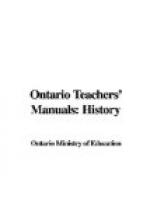2. What the pupils hear should be reinforced by giving them something to see. Whatever pictures are obtainable (see pp. 45, 127) should be used freely at all stages, for the visual images of children are a powerful aid to their understanding; it is for this reason that books for children are now so fully illustrated, and the same principle should be applied to the teaching of history.
As soon as the children are ready for it, reference should be made to maps to illustrate historical facts. (See p. 127.) They should see on the map the course that Columbus took across the unknown sea; Champlain’s explorations become real when they are traced on the map and the children have a concrete picture to carry away with them. In fact the subjects of geography, art, and constructive work, treated under the head of correlated subjects, are used in history with the aim of making it real through the eye. (See pp. 40, 44, 45.)
3. A greater difficulty presents itself when we have to deal, in the higher Forms, with topics like the Magna Charta and the Clergy Reserves, and it is a difficulty that will test to the full the resourcefulness of the teacher. How can the preceding conditions and the terms of the Magna Charta be brought home to a class? How can children be brought to appreciate the difficulties connected with the question of Clergy Reserves? A few words about the latter may suggest a means.
Two aspects of the Clergy Reserves question stand out prominently, the religious and the economic. The religious aspect will be the most difficult for Ontario children, for they have no immediate knowledge of what a State Church is—the point on which the religious dispute turned; nor do they know enough about the government of the religious bodies to which they belong to make the matter clear to them. A full understanding must come later. The best point of approach seems to be to give the class some idea of the number of settlers belonging to the churches of England and of Scotland, which claimed the right to the lands reserved, and compare with this the number of all other Protestant bodies that claimed to share in them; for this difference in numbers was one of the chief causes of bitterness. An arithmetical appeal is concrete. There was also the economic aspect. The Clergy Reserves were one seventh of the land in each township. Another seventh was withheld from free settlement as Crown Lands. Now in some townships there were about 50,000 acres. Let the class find out how many acres were thus kept from settlement. Tell them that this land was not all in one block, but distributed through the township. They can now be asked to consider how this would interfere with close settlement and therefore with the establishment of schools, churches, post-offices, mills, and stores. A diagram of a township would be of great help. These two points will help them to see why an early and fair settlement of the vexed question was desired. Wherever possible, present problems for them to solve by their own experiences.




